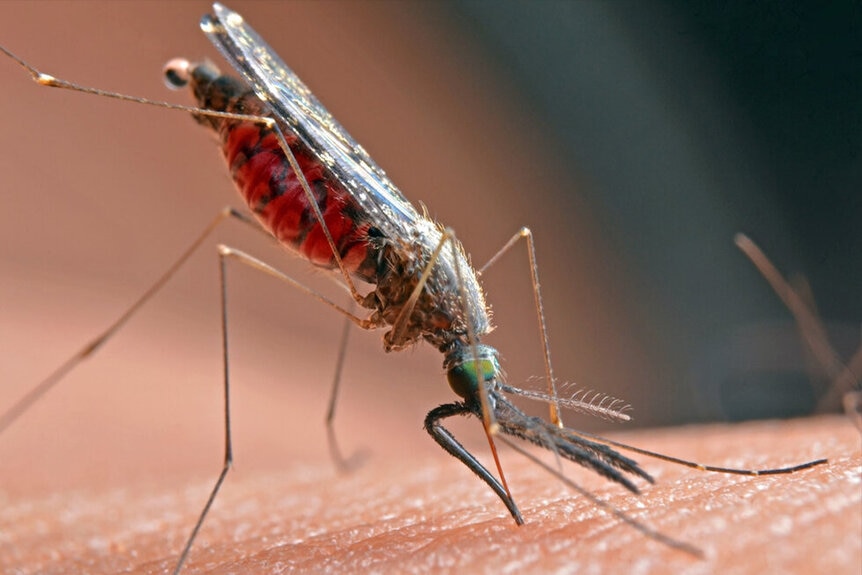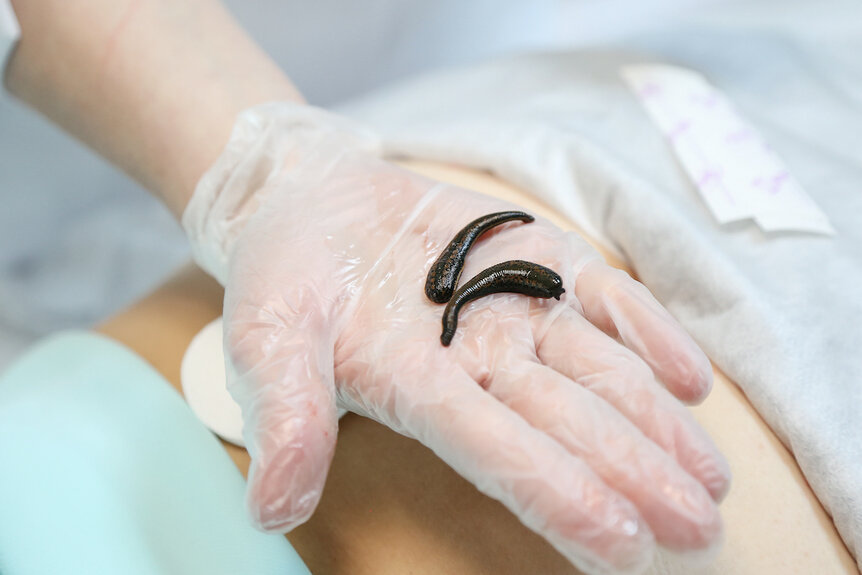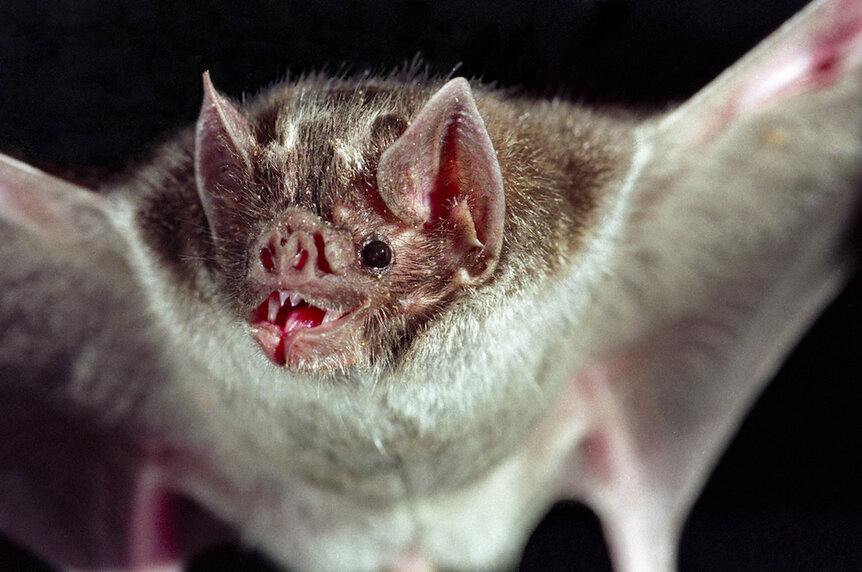Create a free profile to get unlimited access to exclusive videos, sweepstakes, and more!
Who is the ultimate bloodsucker? The science behind 'Renfield'
Ready, fight!

Dracula wasn’t the first vampire, but he’s certainly the most famous. He might have died at the end of the book, but the character appears to have achieved eternal life on page and screen. The master of macrophages returns to the big screen this Friday, April 14, in Renfield.
Directed by Chris McKay (The Lego Movie, The Tomorrow War), starring Nicholas Hoult (Warm Bodies, Mad Max: Fury Road), and Nicolas Cage (from Nicolas Cage), Renfield tells the tale of the world’s most famous vampire (played the way only Cage can), but not from his perspective. Instead, we enter a world of shadow and blood through the eyes of Dracula’s long-suffering servant, the titular Renfield (Hoult). He’s been doing Dracula’s dirty work for centuries, feeding off his power to stay alive and youthful, but he’s growing weary of the arrangement. Renfield wants an ordinary life; he wants out.
RELATED: ‘Renfield’ reviews hail a gory good time elevated by Nicolas Cage’s scene-chewing Dracula
It's a motive most of us can understand. We’ve all had a relationship (or two) which outlived its utility and we struggled to end it. More than that, we relate to Renfield because we too are trapped inside a one-sided blood sucking relationship with the slightly less horrifying but very real vampires of our own planet. If there’s any hope of escaping our own vampiric curse (and we really hope there is) we need to know where to aim the stake. To that end, let’s figure out who holds the title of world’s most voracious vampire.
The Contenders for World's Ultimate Vampiric Creature
There were a lot of entrants, lots of heavy competition for the crown, but not everyone could compete. The list of earthly creatures which consume blood is terrifyingly long. We had to draw the line somewhere. After all, with a loose enough definition, most of us are vampires. Certainly, lions eat blood. You ever seen those dudes chowing down? It’s super bloody, but not monstrous.
For our purposes, we first limited the candidates to animals which survive primarily on blood. Their blood consumption is targeted, not simply a consequence of eating flesh. But even that list is too long. Everything from sea lampreys and certain snails to a species of moth and several birds, make a living by tapping veins. So, we tightened the criteria again.
This time, we looked only at animals who are known to feed on humans and who you might have a reasonable expectation of encountering in a dark alley, forest trail, or body of water. Ultimately, we landed on four contenders: the vampire bat, tick, leech, and mosquito.
Mosquitos and Ticks and Leeches, Oh My!
With a few exceptions (Blade, Josh Hartnett in 30 Days of Night), we think of vampires as all being equally bad, but that isn’t true. Different types of bloodsuckers have different needs, and that can be important if you’re the victim. If you’re Dracula’s familiar and he decides to take a bite, you’re in trouble, but if you’re the familiar to Aedes aegypti, you might be alright.
The first thing you should ask anytime anything wants to punch a straw through your body and take a sip, is how thirsty they are. Mosquitoes take last place in this regard. When a mosquito lands on your arm and ruins your day, its piercing proboscis slurps up about 5 microliters of blood. It’s not a lot, but you’ll spend the next few days missing it while you scratch.
Ticks take third place, but they’re not playing around. A tick doesn’t hit the arterial drive through for a quick bite on its way to parts unknown. Once they take a bite, they stick around and gorge themselves at the all-you-can-eat buffet. On average, they eat three times as much as a mosquito, about 15 microliters.
We jump a few orders of magnitude when we get to leeches. These slimy murder worms can drink more blood than a thousand ticks and still have room for dessert. A leech left to its own devices will drain you of about 10 milliliters of blood.
And then we get to bats. It’s no wonder they are the champions of individual blood consumption. They’re quite a bit larger, which scales the amount of blood needed, but they’re being mammals adds metabolic pressures which ups the energy cost even more. A vampire bat will drink about 30 milliliters of blood at a stretch, if it can get its little hands on it.
If you’re avoiding the vampire who can take the most from you, keep an eye out for vampire bats.
Exsanguination in Context
Sure, vampire bats might pose the biggest risk of sucking you dry out of our four contenders, but they have an unfair advantage. A bat is way bigger than a mosquito, which is probably why the vampire bat’s insectivore relatives make a habit of eating so many of them.
Judging a tick against a leech’s chugging abilities is like asking the world’s strongest second grader to out-punch Mike Tyson. It’s not going to happen; we don’t care how ripped that kid is. A better test would be to see how their gluttony compares to their fasting weight. Who jams the most blood into their respective feedbag, all things being equal?
To find out, we converted the above blood meal volumes to weight. A milliliter of human blood weighs about 1.06 grams, so it’s a pretty simple multiplicative conversion. If you bounce the blood meal weight against the average body weight, you get a blood meal to body ratio. Before we get started, it’s worth noting that the average person weighs 136 pounds and eats about three pounds of food per day. That’s a meal to weight ratio of just over 2%. It takes about six weeks of regular meals to eat your body weight in food.
RELATED: Before 'Renfield,' revisit the weirdest Dracula movies ever made
Using this measurement, bats are at the bottom of the pack. The average vampire bat weighs 28.35 grams and eats 31.8 grams of blood in a meal. The trip home from dinner is a lot harder because the bat is carrying more than its whole body weight inside its fuzzy little tummy. Vampire bats have a blood meal to body ratio of 112.17%.
Mosquitos might have a small cargo area, but they make up for it in gumption. Weighing in at just 0.0025 grams, they regularly drink twice that much blood. Their 5 microliter blood meal weighs more than twice their starving weight, effectively tripling their body weight when they eat. Their meal to weight ratio is 212%. That would be like you sitting down and consuming two entire people for lunch, bones and all.
If you thought doubling or tripling your body weight with foreign blood was impressive, you haven’t seen anything yet. A successful tick can increase its body size more than six-fold while it’s latched onto its prey. Building the equivalent of five extra bodies requires a lot of blood. An average tick starts even smaller than a mosquito at 0.0017 grams but can drink 15 microliters, fully three times as much as a mosquito. Consequently, they have a meal to weight ratio of 935.29%.
But leeches take the prize. A leech can suck down 10.6 grams of blood in a meal. You would have to put 28 hungry leeches on the scale to balance out one hungry bat, but after they are fed, you would only need three. Leeches drink 10 times their body weight in blood, with a ratio of more than 1,000%.
Dracula drinking one or two people at a time… those are rookie numbers.
What Should You Do If You've Been Bitten by a Vampiric Creature?
The world is filled with all manner of blood thieves, big and small, many of whom will take a bite out of you given half a chance. Still, we’ve all gotten a mosquito bite (probably more than we care to remember). Leech and tick encounters are common occurrences if you spend time in the wilderness, and even vampire bat bites happen. Yet, most of us come out the other side of those encounters without any problems.
The threat of disease is certainly an issue, particularly with mosquitos. A bite from the wrong mosquito could deliver Zika, West Nile, dengue, or malaria, just to name a few. Mosquitos are, without a doubt, the single deadliest creatures on the planet. Likewise, ticks carry a wide variety of diseases. Lyme is most commonly cited but there are a total of 16 tick-borne diseases listed by the CDC. Vampire bats transmit rabies and a number of other pathogens through their bites. Only leeches seem to present little if any risk of disease. Their impact is more nebulous, with conflicting reports as to whether leech-borne diseases are something we should be worried about.
RELATED: Hold the Lyme – these genetically modified ticks could reduce human disease
They don’t appear to transmit diseases on the same scale as mosquitos, ticks, or even bats, but they do hold onto the blood of humans or other animals in their gut, and lab experiments have confirmed that at least some pathogens can remain active in their bodies for months. If a leech bites a sick person or animal, stores that pathogen and later bites you, it’s feasible that the disease could be passed to your body.
Like all the best vampires, however, leeches have a trick up their sleeve. They don’t need diseases to be horrifying. Leeches from the family Praobdellidae have a unique feeding strategy involving the mucous membranes of their host. They aren’t satisfied with the skin outside of your body and instead seek out the mushier parts inside.
Once they’ve marked you as their meal, they’ll get inside of your body any way they can. That might involve traveling through an orifice like the mouth or nostril, but it can also involve the openings at the other end of your body. There are even reports of leeches getting into the body through the ears, eyes, or by tunneling straight through the exterior.
Once inside, they’ll stay there for weeks or months feeding on your fresh blood, undisturbed. Some victims report fever, vomiting, and the sensation of foreign body movement inside them.
All things considered, a couple hours watching Dracula feast on the living feels like a nice distraction from the horrors of reality. Renfield hits theaters this Friday, April 14. Buy tickets here!





























